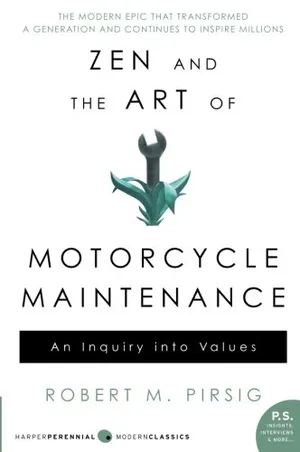The Cycle From ‘Zen and the Art of Motorcycle Maintenance’ Comes to the Smithsonian
The 1966 Honda Super Hawk featured in Robert Pirsig’s book on values was recently acquired by the National Museum of American History
/https://tf-cmsv2-smithsonianmag-media.s3.amazonaws.com/filer/92/9f/929fa157-5df7-4c72-910e-e970230a6cbe/jn2019-02070-1.gif)
One of the most famous vehicles in literature is coming to the Smithsonian’s National Museum of American History. The 1966 Honda Super Hawk ridden by writer Robert Pirsig when he took the trip that inspired the book of travel and philosophy, Zen and the Art of Motorcycle Maintenance, was donated to the museum by Pirsig’s widow Wendy K. Pirsig, along with the leather jacket, maps and other gear from the ride.
The cycle was previously stored in the family’s garage and was recently restored to riding condition. A manuscript copy of Zen and the Art of Motorcycle Maintenance and a signed first edition of the book are also part of the donation.
The motorcycle as a mode of long-distance transportation has a certain aura surrounding it, rooted in the simple and versatile bikes developed for soldiers during the two world wars. The practicality of a motorcycle—a small and light vehicle with low fuel consumption and an easily accessible and simple engine—naturally appealed to many of the adventurous travelers of the 20th century.
Che Guevara famously developed many of his revolutionary ideas while on a motorcycle trip across South America in 1952, riding a 1939 Norton named La Poderosa II, or “The Mighty One II,” as chronicled in the The Motorcycle Diaries. Travel writer Ted Simon circumnavigated the globe in the 1970s on a Triumph Tiger 100, riding across 45 countries, a story he tells in Jupiter’s Travels.
But perhaps the most influential book on motorcycle travel is Pirsig’s Zen, published in 1974. Based on a 5,700-mile trip Pirsig took with his son in 1968 from Minneapolis, Minnesota, to San Francisco, California, the fictionalized travelogue, full of philosophical ruminations, has inspired millions of riders, tinkerers, wanderers and thinkers. Subtitled An Inquiry Into Values, the book explores the human relationship to technology via the lens of a traveling rider keeping his machine running.
“You see things vacationing on a motorcycle in a way that is completely different from any other,” writes Pirsig in Zen.
Zen and the Art of Motorcycle Maintenance: An Inquiry Into Values
A narration of a summer motorcycle trip undertaken by a father and his son, Zen and the Art of Motorcycle Maintenance becomes a personal and philosophical odyssey into fundamental questions on how to live.
The book captures the joys of traveling by motorcycle, such as a more direct connection to nature than in a car or on a train, and the thrill of leaning a bike through curvy backroads away from all the traffic of an interstate and the chaos of a major city. Riding a motorcycle requires one’s full attention, producing a greater sense of awareness of the surrounding environment. For these reasons, riders generally plan their road trips over several days, providing time to stop frequently and explore the little towns and natural wonders of a country.
“This is the most famous forgotten motorcycle in American history and literature,” says Paul Johnston, curator of transportation at the National Museum of American History, in a press release. “Pirsig was a trailblazer in motorcycle touring and documenting its celebration of freedom and the open road.”
Zen and the Art of Motorcycle Maintenance is not just for gearheads, though. A thoughtful reflection on philosophy, ranging from the ancient Greeks to Taoism, is woven throughout the story. Pirsig attempts to reconcile two opposing human desires: to pursue an aesthetic life devoted to metaphysical knowledge and the arts, and to understand the practical workings of technology and machines. The first point of view is reflected by two travel companions who join the narrator, John and Sylvia Sutherland. The pair ride a new BMW that they would rather take to a trained mechanic than work on themselves; by contrast, the narrator, or Pirsig himself, rides an older, more simple Honda that he has learned to tune and maintain.
Ultimately, Pirsig concedes that the ugly and unnatural aspects of technology and industrialization can be off-putting to those who would pursue a life of aesthetic and artistic beauty. He advocates for balance, suggesting that one can both explore the metaphysical qualities of life and stay connected to the more grounded functions of the machines we build. The book explores the concept of “quality” as a measure of a good life.
“Bob’s philosophy explored human values, and he aimed to show how quality is actually at the center of all existence,” Wendy Pirsig says. “It seems consistent with this focus on quality that his motorcycle collection joins the nation’s exemplary history museum at the Smithsonian.”
Technology has advanced significantly since the 1974 publication of Zen and the Art of Motorcycle Maintenance, and some of the criticisms of over-reliance on technology in the book sound like they could have been written about the 21st century.
“We’re in such a hurry most of the time we never get much chance to talk,” Pirsig writes. “The result is a kind of endless day-to-day shallowness, a monotony that leaves a person wondering years later where all the time went and sorry that it’s all gone.”
As humanity races into an automated world of gadgets and gizmos that we can operate without any understanding of how they work, Pirsig’s book on finding a balance between intellectual and practical pursuits, and the motorcycle that inspired its writing, may be more important now than ever.
A Note to our Readers
Smithsonian magazine participates in affiliate link advertising programs. If you purchase an item through these links, we receive a commission.
/https://tf-cmsv2-smithsonianmag-media.s3.amazonaws.com/accounts/headshot/bennett.jpg)

/https://tf-cmsv2-smithsonianmag-media.s3.amazonaws.com/accounts/headshot/bennett.jpg)